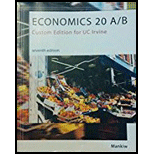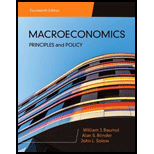
(a):
Meaning of the equation.
(a):
Explanation of Solution
Consumption spending: Consumption spending refers to the amount of expenditure incurred for consuming goods and services at a particular tie period with the given level of income.
Investment: An investment is the money invested in terms of assets and buildings by the individual, for future consumption and profit making.
GDP (Gross domestic product): GDP refers to the market value of all final goods and services produced in an economy during an accounting year.
Multiplier: Multiplier refers to the ratio of change in the real GDP to the change in initial consumption at a constant
Marginal propensity to consume (MPC): Marginal propensity to consume refers to the sensitivity of change in the consumption level, due to the changes that have occurred in the income level.
(b):
Marginal propensity to consume.
(b):
Explanation of Solution
The slope of the consumption function is the marginal propensity to consume (MPC). Since the consumption function is
Consumption spending: Consumption spending refers to the amount of expenditure incurred for consuming goods and services at a particular tie period with the given level of income.
Investment: An investment is the money invested in terms of assets and buildings by the individual, for future consumption and profit making.
GDP (Gross domestic product): GDP refers to the market value of all final goods and services produced in an economy during an accounting year.
Multiplier: Multiplier refers to the ratio of change in the real GDP to the change in initial consumption at a constant price rate. A multiplier is positively related to the marginal propensity to consume and negatively related with the marginal propensity to save.
Marginal propensity to consume (MPC): Marginal propensity to consume refers to the sensitivity of change in the consumption level, due to the changes that have occurred in the income level.
(c):
Compare with full employmnet level.
(c):
Explanation of Solution
Since the interest rate r is 4 percent, the GDP can be equated as follows:
The GDP is 1800. The calculated GDP
Consumption spending: Consumption spending refers to the amount of expenditure incurred for consuming goods and services at a particular tie period with the given level of income.
Investment: An investment is the money invested in terms of assets and buildings by the individual, for future consumption and profit making.
GDP (Gross domestic product): GDP refers to the market value of all final goods and services produced in an economy during an accounting year.
Multiplier: Multiplier refers to the ratio of change in the real GDP to the change in initial consumption at a constant price rate. A multiplier is positively related to the marginal propensity to consume and negatively related with the marginal propensity to save.
Marginal propensity to consume (MPC): Marginal propensity to consume refers to the sensitivity of change in the consumption level, due to the changes that have occurred in the income level.
(d):
Impact of change in government purchase.
(d):
Explanation of Solution
Assuming no change in
Since the MPC is 0.75, the multiplier can be calculated thus
The multiplier is 4. Thus, to increase GDP by 200
Consumption spending: Consumption spending refers to the amount of expenditure incurred for consuming goods and services at a particular tie period with the given level of income.
Investment: An investment is the money invested in terms of assets and buildings by the individual, for future consumption and profit making.
GDP (Gross domestic product): GDP refers to the market value of all final goods and services produced in an economy during an accounting year.
Multiplier: Multiplier refers to the ratio of change in the real GDP to the change in initial consumption at a constant price rate. A multiplier is positively related to the marginal propensity to consume and negatively related with the marginal propensity to save.
Marginal propensity to consume (MPC): Marginal propensity to consume refers to the sensitivity of change in the consumption level, due to the changes that have occurred in the income level.
(e):
Change in interest rate to bring the economy back to full employment level.
(e):
Explanation of Solution
Assuming no change in fiscal policy, a decrease in interest rate would restore full employment. The amount at which the interest rate needs to be decreased can be calculated as follows:
The interest rate needs to be 3 percent for full employment. Thus, a decrease of 1 percent
Consumption spending: Consumption spending refers to the amount of expenditure incurred for consuming goods and services at a particular tie period with the given level of income.
Investment: An investment is the money invested in terms of assets and buildings by the individual, for future consumption and profit making.
GDP (Gross domestic product): GDP refers to the market value of all final goods and services produced in an economy during an accounting year.
Multiplier: Multiplier refers to the ratio of change in the real GDP to the change in initial consumption at a constant price rate. A multiplier is positively related to the marginal propensity to consume and negatively related with the marginal propensity to save.
Marginal propensity to consume (MPC): Marginal propensity to consume refers to the sensitivity of change in the consumption level, due to the changes that have occurred in the income level.
Want to see more full solutions like this?
Chapter 34 Solutions
PRINC OF ECONOMICS PKG >CUSTOM<
- 19. In a paragraph, no bullet, points please answer the question and follow the instructions. Give only the solution: Use the Feynman technique throughout. Assume that you’re explaining the answer to someone who doesn’t know the topic at all. How does the Federal Reserve currently get the federal funds rate where they want it to be?arrow_forward18. In a paragraph, no bullet, points please answer the question and follow the instructions. Give only the solution: Use the Feynman technique throughout. Assume that you’re explaining the answer to someone who doesn’t know the topic at all. Carefully compare and contrast fiscal policy and monetary policy.arrow_forward15. In a paragraph, no bullet, points please answer the question and follow the instructions. Give only the solution: Use the Feynman technique throughout. Assume that you’re explaining the answer to someone who doesn’t know the topic at all. What are the common arguments for and against high levels of federal debt?arrow_forward
- 17. In a paragraph, no bullet, points please answer the question and follow the instructions. Give only the solution: Use the Feynman technique throughout. Assume that you’re explaining the answer to someone who doesn’t know the topic at all. Explain the difference between present value and future value. Be sure to use and explain the mathematical formulas for both. How does one interpret these formulas?arrow_forward12. Give the solution: Use the Feynman technique throughout. Assume that you’re explaining the answer to someone who doesn’t know the topic at all. Show and carefully explain the Taylor rule and all of its components, used as a monetary policy guide.arrow_forward20. In a paragraph, no bullet, points please answer the question and follow the instructions. Give only the solution: Use the Feynman technique throughout. Assume that you’re explaining the answer to someone who doesn’t know the topic at all. What is meant by the Federal Reserve’s new term “ample reserves”? What may be hidden in this new formulation by the Fed?arrow_forward
- 14. In a paragraph, no bullet, points please answer the question and follow the instructions. Give only the solution: Use the Feynman technique throughout. Assume that you’re explaining the answer to someone who doesn’t know the topic at all. What is the Keynesian view of fiscal policy and why are some economists skeptical?arrow_forward16. In a paragraph, no bullet, points please answer the question and follow the instructions. Give only the solution: Use the Feynman technique throughout. Assume that you’re explaining the answer to someone who doesn’t know the topic at all. Describe a bond or Treasury security. What are its components and what do they mean?arrow_forward13. In a paragraph, no bullet, points please answer the question and follow the instructions. Give only the solution: Use the Feynman technique throughout. Assume that you’re explaining the answer to someone who doesn’t know the topic at all. Where does the government get its funds that it spends? What is the difference between federal debt and federal deficit?arrow_forward
- 11. In a paragraph, no bullet, points please answer the question and follow the instructions. Give only the solution: Use the Feynman technique throughout. Assume that you’re explaining the answer to someone who doesn’t know the topic at all. Why is determining the precise interest rate target so difficult for the Fed?arrow_forwardProblem 1 Regression Discontinuity In the beginning of covid, the US government distributed covid stimulus payments. Suppose you are interested in the effect of receiving the full amount of the first stimulus payment on the total spending in dollars by single individuals in the month after receiving the payment. Single individuals with annual income below $75,00 received the full amount of the stimulus payment. You decide to use Regression Discontinuity to answer this question. The graph below shows the RD model. 3150 3100 3050 Total Spending in the month after receiving the stimulus payment 2950 3000 74000 74500 75000 75500 76000 Annual income a. What is the outcome? (5 points) b. What is the treatment? (5 points) C. What is the running variable? (5 points) d. What is the cutoff? (5 points) e. Who is in the treatment group and who is in the control group? (10 points) f. What is the discontinuity in the graph and how do you interpret it? (10 points) g. Explain a scenario which can…arrow_forwardProblem 2 Difference-in-Difference In the beginning of 2005, Minnesota increased the sales tax on alcohol. Suppose you are interested in studying the effect of the increase in sale taxes on alcohol on the number of car accidents due to drinking in Minnesota. Unlike Minnesota, Wisconsin did not change the sales tax on alcohol. You decide to use a Difference-in-difference (DID) Model. The numbers of car accidents in each state at the end of 2004 and 2005 are as follows: Year Number of car accidents in Minnesota Number of car accidents in Wisconsin 2004 2000 2500 2005 2500 3500 a. Which state is the treatment state and which state is the control state? (10 points) b. What is the change in the outcome for the treatment group between 2004 and 2005? (5 points) C. Can we interpret the change in the outcome for the treatment group between 2004 and 2005 as the causal effect of the policy on car accidents? Explain your answer. (10 points) d. What is the change in the outcome for the control…arrow_forward

 Economics (MindTap Course List)EconomicsISBN:9781337617383Author:Roger A. ArnoldPublisher:Cengage Learning
Economics (MindTap Course List)EconomicsISBN:9781337617383Author:Roger A. ArnoldPublisher:Cengage Learning

 Essentials of Economics (MindTap Course List)EconomicsISBN:9781337091992Author:N. Gregory MankiwPublisher:Cengage Learning
Essentials of Economics (MindTap Course List)EconomicsISBN:9781337091992Author:N. Gregory MankiwPublisher:Cengage Learning Brief Principles of Macroeconomics (MindTap Cours...EconomicsISBN:9781337091985Author:N. Gregory MankiwPublisher:Cengage Learning
Brief Principles of Macroeconomics (MindTap Cours...EconomicsISBN:9781337091985Author:N. Gregory MankiwPublisher:Cengage Learning





